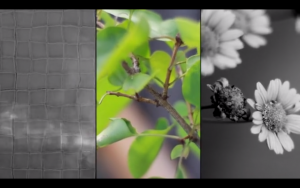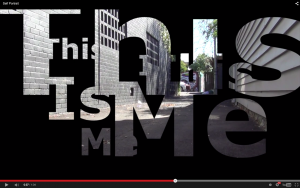In our tutorials this week, we presented our self portraits to a small group of people, who then critiqued our work using four Edward de Bono’s thinking hats from his Six Hat system.
We utilised:
– Yellow hat, characterised by positive and optimistic thoughts (highlighting what worked well)
– Red hat, which relies on gut reaction and telling the creator your initial feelings
– Black hat, pertaining to things that aren’t quite working (presented in a constructive way)
– Green hat, which offers alternatives and creative ideas.
For each person in my group, I offered my thoughts from the yellow hat perspective.
Gloria:
Concept – create a collection of media that portray her personality, through what is seen in images/videos but also the composition of each element.
1. Audio: layering of music and sound effects gave listener a sense of being in the room with her – clear she was studying whilst other things were going on around her
2. Text: published her words so they were set out in the shape of a person – added another dimension to the words as we read them and says that little bit extra
3. Included both abstract and realistic pieces of media to give a fuller picture of her personality and the reality of her life
Maggie:
Concept – (parody) “I’m not that complex a person. I took the idea of a person making a movie of my life that really wouldn’t be that interesting.” She explored production elements of this film as her self portrait.
1. SO CREATIVE. The vision for the self portrait flowed through every element – the concept said more about her personality than each specific element did and this is hard to do.
2. Text: (cover of a film script) perfect jumping off point tying all other elements together, funny, said more than just what was written on the page – gave context to the work
3. Audio: Maggie winning an Oscar for her work – demonstrated her aspirations, not only what she is like now
Daniel:
Concept – demonstrate multiple sides of his personality to show as much of himself as possible. In a sense, he portrayed himself as an outsider looking into his life at the same time as the audience.
1. Photograph: one image presented a metaphor for his personality rather than anything directly connected to his life – interesting concept
2. Video: filming his music editing felt like we were finally getting inside his mind and his world – contrasted anonymity running through the rest of the work nicely
3. Audio: even gave the clip a name – “Joke Time With Daniel,” laughed at his own jokes – perfectly demonstrated a sense of humour
Each person in my group had their own unique approach to the task, which I found quite interesting. I also discovered that everyone was willing to share a different level of their personal life and of who they think they are. As we were presenting we often apologised for our work, like we were embarrassed to show what we had done, but then we all presented something that was praised by the other members of our group. I think what I’ll take from this is that the fact that we need to own our ideas and be proud of our own unique interpretations of each Project Brief.

